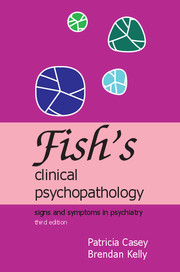Book contents
- Frontmatter
- Contents
- The authors
- Preface
- 1 Classification of psychiatric disorders
- 2 Disorders of perception
- 3 Disorders of thought and speech
- 4 Disorders of memory
- 5 Disorders of emotion
- 6 Disorders of the experience of self
- 7 Disorders of consciousness
- 8 Motor disorders
- 9 Personality disorders
- Appendix I Psychiatric syndromes
- Appendix II Defences and distortions
- Index
3 - Disorders of thought and speech
Published online by Cambridge University Press: 15 February 2018
- Frontmatter
- Contents
- The authors
- Preface
- 1 Classification of psychiatric disorders
- 2 Disorders of perception
- 3 Disorders of thought and speech
- 4 Disorders of memory
- 5 Disorders of emotion
- 6 Disorders of the experience of self
- 7 Disorders of consciousness
- 8 Motor disorders
- 9 Personality disorders
- Appendix I Psychiatric syndromes
- Appendix II Defences and distortions
- Index
Summary
Disorders of thought include disorders of intelligence, stream of thought and possession of thought, obsessions and compulsions and disorders of the content and form of thinking.
Disorders of intelligence
Intelligence is the ability to think and act rationally and logically. The measurement of intelligence is both complex and controversial (Ardila, 1999). In practice, intelligence is measured with tests of the ability of the individual to solve problems and to form concepts through the use of words, numbers, symbols, patterns and non-verbal material. The precise age at which intellectual growth appears to slow down depends on the type of test used, but it now appears that intelligence, as measured by intelligence tests, begins its slow decline in middle-age and proceeds significantly less rapidly than previously believed (McPherson, 1996).
The most common way of measuring intelligence is in terms of the distribution of scores in the population. The person who has an intelligence score on the 75 percentile has a score that is such that 75% of the appropriate population score less and 25% score more. Some intelligence tests used for children give a score in terms of the mental age, which is the score achieved by the average child of the corresponding chronological age. For historical reasons, most intelligence tests are designed to give a mean IQ of the population of 100 with a standard deviation of 15. Even if the distribution of scores is not normal, percentiles can be converted into standard units without difficulty and this is probably the best way of measuring intelligence.
Intelligence scores in a group of randomly chosen subjects of the same age tends to have a normal distribution, but this only applies over most of the range of scores. Towards the lower end of the range there is an increase in the incidence of low intelligence that is the result of brain damage caused by inherited disorders, birth trauma, infections and so on. There are, therefore, two groups of subjects with low intelligence or what is now termed ‘learning disability’ or ‘intellectual disability’. The first group comprises individuals whose intelligence is at the lowest end of the normal range and is therefore a quantitative deviation from the normal. The other group of individuals with learning disability comprise individuals with specific learning disabilities.
- Type
- Chapter
- Information
- Fish's Clinical PsychopathologySigns and Symptoms in Psychiatry, pp. 32 - 54Publisher: Royal College of PsychiatristsPrint publication year: 2007



